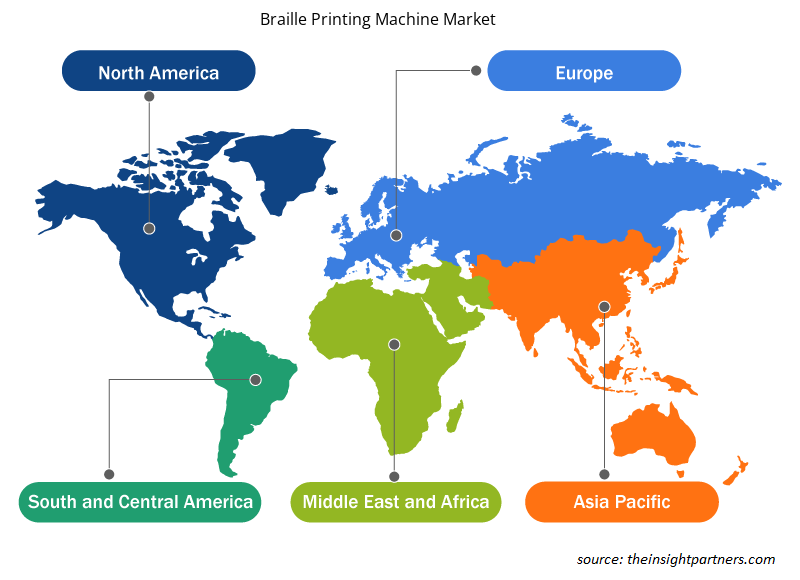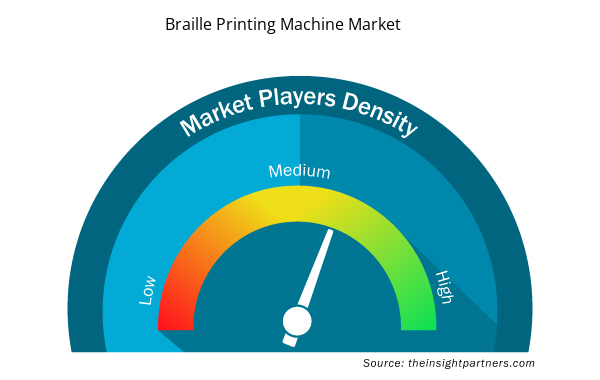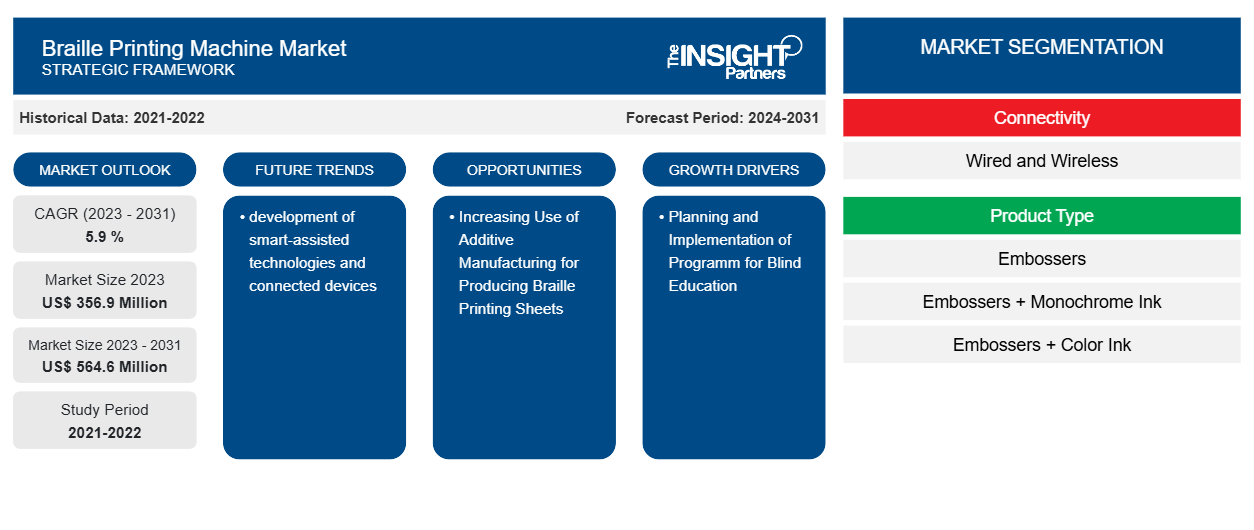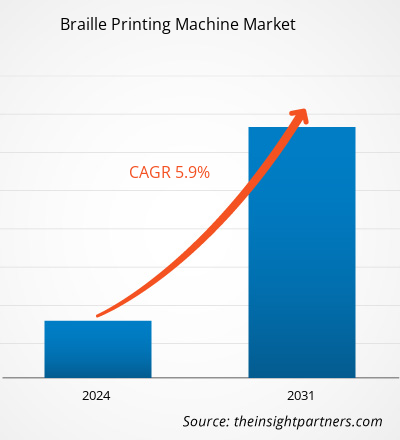Der Markt für Braille-Druckmaschinen soll von 356,9 Millionen US-Dollar im Jahr 2023 auf 564,6 Millionen US-Dollar im Jahr 2031 anwachsen. Der Markt wird zwischen 2023 und 2031 voraussichtlich eine durchschnittliche jährliche Wachstumsrate von 5,9 % verzeichnen. Die Entwicklung intelligenter Technologien und vernetzter Geräte dürfte ein wichtiger Trend auf dem Markt bleiben.CAGR of 5.9 % during 2023–2031. The development of smart-assisted technologies and connected devices is likely to remain a key trend in the market.
Braille-Druckmaschinen Marktanalyse
Die Braille-Druckmaschine ist ein an einen Computer angeschlossener Drucker, mit dem eine Braille-Kopie eines Textes erstellt wird. Ein Braille-Drucker kann für denselben Zweck auch an Braille-Notizgeräte angeschlossen werden. Mit einem Braille-Drucker kann ein Schüler eine Braille-Kopie seiner Notizen und schriftlichen Arbeiten drucken. Die Druckgeräte benötigen schweres Papier und die meisten Modelle drucken nur auf einer Seite.
Marktübersicht für Braille-Druckmaschinen
Brailledrucker empfangen Informationen von Computergeräten und prägen diese Informationen in Blindenschrift auf Papier , indem sie Magnetspulen verwenden, die die Prägestifte steuern. Brailledrucker verwenden in der Regel mehr Seiten für die gleiche Menge an Informationen als Seiten, die auf einem normalen Drucker gedruckt werden. Brailledrucker, auch Braille-Prägegeräte genannt, können es blinden Menschen, die eine Sehbehinderung haben, viel einfacher machen, lesbare Dokumente auszudrucken. Von wichtigen Dokumenten bis hin zu Sicherungskopien von Briefen und Formularen kann ein Brailledrucker eine nützliche Ergänzung im Alltag sein.
Passen Sie diesen Bericht Ihren Anforderungen an
Sie erhalten kostenlos individuelle Anpassungen an jedem Bericht, einschließlich Teilen dieses Berichts oder einer Analyse auf Länderebene, eines Excel-Datenpakets sowie tolle Angebote und Rabatte für Start-ups und Universitäten.
- Holen Sie sich die wichtigsten Markttrends aus diesem Bericht.Dieses KOSTENLOSE Beispiel umfasst eine Datenanalyse von Markttrends bis hin zu Schätzungen und Prognosen.
Markttreiber und Chancen für Braille-Druckmaschinen
Planung und Umsetzung eines Programms zur Blindenbildung zur Förderung des Marktes
Die NFB BELL Academy bietet Kindern Braille- und nicht-visuelle Fähigkeiten durch unterhaltsame, praktische Lernaktivitäten an. Je nach Standort werden die Aktivitäten in einem Tagesprogramm oder in einer Unterkunft angeboten. Das Programm ist für blinde und sehbehinderte Kinder im Alter von vier bis zwölf Jahren konzipiert. Erfahren Sie mehr über die NFB BELL Academy. Advocacy and Awareness, die National Association for the Blind Delhi, engagiert sich jedoch in Lobbyarbeit, um das Bewusstsein für die Bedeutung integrativer Bildung zu schärfen und sich für Richtlinien einzusetzen, die das Recht sehbehinderter Schüler auf qualitativ hochwertige Bildung in regulären Einrichtungen unterstützen. Solche Initiativen treiben weltweit das Wachstum des Marktes voran.
Additive Fertigung zur Herstellung von Braille-Druckbögen wird zunehmend eingesetzt
Braille-Druck unterstützt blinde und sehbehinderte Menschen beim Lesen und wird deshalb überall eingesetzt. Der Druck von Braille auf Verpackungen hilft blinden Menschen, sich besser zu orientieren und Informationen zu erhalten. Insbesondere bei Verpackungen für Arzneimittel gelten besondere Kennzeichnungspflichten – auch in Braille-Schrift. Aufgrund seiner enormen Anwendung wird die additive Fertigung zur Herstellung von Braille-Druckbögen eingesetzt. Daher bietet die zunehmende Nutzung der additiven Fertigung zur Herstellung von Braille-Druckbögen eine lukrative Möglichkeit für das Wachstum des Marktes.
Segmentierungsanalyse des Marktberichts für Braille-Druckmaschinen
Wichtige Segmente, die zur Ableitung der Marktanalyse für Braille-Druckmaschinen beigetragen haben, sind Konnektivität, Produkttyp, Anwendung und Sektor.
- Basierend auf der Konnektivität wird der Markt für Braille-Druckmaschinen in kabelgebundene und kabellose Geräte segmentiert.
- Basierend auf dem Produkttyp ist der Markt für Braille-Druckmaschinen in Prägegeräte, Prägegeräte + Monochromtinte und Prägegeräte + Farbtinte segmentiert.
Braille-Druckmaschinen Marktanteilsanalyse nach Geografie
Der geografische Umfang des Marktberichts für Braille-Druckmaschinen ist hauptsächlich in fünf Regionen unterteilt: Nordamerika, Asien-Pazifik, Europa, Naher Osten und Afrika sowie Süd- und Mittelamerika. Organisationen und Einzelpersonen auf der ganzen Welt haben sich für ein stärkeres Bewusstsein für und einen besseren Zugang zu Braille-Materialien und -Technologie eingesetzt. Im Jahr 2021 feierten Befürworter und Experten in Kamerun den Welt-Braille-Tag (4. Januar) mit Aktivitäten und einer Kundgebung. Reporter stellten fest, dass „blinde Demonstranten sagten, das Braille-System helfe ihnen, ihre Ausbildung voranzutreiben, ihre Unabhängigkeit zu erlangen und den Bedarf an Unterstützung zu verringern“ und forderten eine stärkere Unterstützung für Pädagogen, „Braille in Lehrerausbildungseinrichtungen“ zu lernen.
Regionale Einblicke in den Markt für Braille-Druckmaschinen
Die regionalen Trends und Faktoren, die den Markt für Braille-Druckmaschinen im Prognosezeitraum beeinflussen, wurden von den Analysten von Insight Partners ausführlich erläutert. In diesem Abschnitt werden auch die Marktsegmente und die Geografie von Braille-Druckmaschinen in Nordamerika, Europa, im asiatisch-pazifischen Raum, im Nahen Osten und Afrika sowie in Süd- und Mittelamerika erörtert.

- Erhalten Sie regionale Daten zum Markt für Braille-Druckmaschinen
Umfang des Marktberichts zu Braille-Druckmaschinen
| Berichtsattribut | Details |
|---|---|
| Marktgröße im Jahr 2023 | 356,9 Millionen US-Dollar |
| Marktgröße bis 2031 | 564,6 Millionen US-Dollar |
| Globale CAGR (2023 - 2031) | 5,9 % |
| Historische Daten | 2021-2022 |
| Prognosezeitraum | 2024–2031 |
| Abgedeckte Segmente | Nach Konnektivität
|
| Abgedeckte Regionen und Länder | Nordamerika
|
| Marktführer und wichtige Unternehmensprofile |
|
Marktteilnehmerdichte für Braille-Druckmaschinen: Auswirkungen auf die Geschäftsdynamik verstehen
Der Markt für Braille-Druckmaschinen wächst rasant, angetrieben durch die steigende Nachfrage der Endnutzer aufgrund von Faktoren wie sich entwickelnden Verbraucherpräferenzen, technologischen Fortschritten und einem größeren Bewusstsein für die Vorteile des Produkts. Mit steigender Nachfrage erweitern Unternehmen ihr Angebot, entwickeln Innovationen, um die Bedürfnisse der Verbraucher zu erfüllen, und nutzen neue Trends, was das Marktwachstum weiter ankurbelt.
Die Marktteilnehmerdichte bezieht sich auf die Verteilung der Firmen oder Unternehmen, die in einem bestimmten Markt oder einer bestimmten Branche tätig sind. Sie gibt an, wie viele Wettbewerber (Marktteilnehmer) in einem bestimmten Marktraum im Verhältnis zu seiner Größe oder seinem gesamten Marktwert präsent sind.
Die wichtigsten auf dem Markt für Braille-Druckmaschinen tätigen Unternehmen sind:
- American Thermoform
- Baumer HHS GmbH
- Humanware-Gruppe
- Index Braille
- Nippon Telesoft Co. Ltd.
- Harpo sp. ZOO
Haftungsausschluss : Die oben aufgeführten Unternehmen sind nicht in einer bestimmten Reihenfolge aufgeführt.

- Überblick über die wichtigsten Akteure auf dem Markt für Braille-Druckmaschinen
Neuigkeiten und aktuelle Entwicklungen zum Markt für Braille-Druckmaschinen
Der Markt für Braille-Druckmaschinen wird durch die Erhebung qualitativer und quantitativer Daten nach Primär- und Sekundärforschung bewertet, die wichtige Unternehmensveröffentlichungen, Verbandsdaten und Datenbanken umfasst. Nachfolgend sind einige der Entwicklungen auf dem Markt für Braille-Druckmaschinen aufgeführt:
- Tecnovisão und HumanWare gehen eine Vertriebspartnerschaft in Brasilien ein. Diese Partnerschaft ermöglicht es HumanWare, seine innovativen Lösungen für Blindheit und Sehbehinderung einer größeren Zahl von Kunden in Brasilien zugänglich zu machen.
(Quelle: Tecnovisão, April 2021)
- Zychem Limited freut sich, in Zusammenarbeit mit seiner Muttergesellschaft American Thermoform den Swell Form Pro vorstellen zu dürfen, eine hochmoderne Maschine für taktile Grafiken zur Erstellung von Lehrprodukten für Blinde und Sehbehinderte.
(Quelle: Zychem Limited, Juni 2024)
Marktbericht zu Braille-Druckmaschinen – Umfang und Ergebnisse
Der Bericht „Marktgröße und Prognose für Braille-Druckmaschinen (2021–2031)“ bietet eine detaillierte Analyse des Marktes, die die folgenden Bereiche abdeckt:
- Marktgröße und Prognose für Braille-Druckmaschinen auf globaler, regionaler und Länderebene für alle wichtigen Marktsegmente, die im Rahmen des Berichts abgedeckt sind
- Markttrends für Braille-Druckmaschinen sowie Marktdynamik wie Treiber, Einschränkungen und wichtige Chancen
- Detaillierte PEST/Porters Five Forces- und SWOT-Analyse
- Marktanalyse für Braille-Druckmaschinen mit Blick auf wichtige Markttrends, globale und regionale Rahmenbedingungen, wichtige Akteure, Vorschriften und aktuelle Marktentwicklungen
- Branchenlandschaft und Wettbewerbsanalyse, die die Marktkonzentration, Heatmap-Analyse, prominente Akteure und aktuelle Entwicklungen auf dem Markt für Braille-Druckmaschinen umfasst
- Detaillierte Firmenprofile
- Historische Analyse (2 Jahre), Basisjahr, Prognose (7 Jahre) mit CAGR
- PEST- und SWOT-Analyse
- Marktgröße Wert/Volumen – Global, Regional, Land
- Branche und Wettbewerbsumfeld
- Excel-Datensatz



Report Coverage
Revenue forecast, Company Analysis, Industry landscape, Growth factors, and Trends

Segment Covered
This text is related
to segments covered.

Regional Scope
North America, Europe, Asia Pacific, Middle East & Africa, South & Central America

Country Scope
This text is related
to country scope.
Häufig gestellte Fragen
The market is expected to register a CAGR of 5.9% during 2023–2031.
The global braille printing machine market is expected to reach US$ 564.6 million by 2031.
The development of smart-assisted technologies and connected devices to play a significant role in the global braille printing machine market in the coming years.
The leading players operating in the global braille printing machine market are American Thermoform, Baumer HHS GmBH, Humanware Group, Index Braille, Nippon Telesoft Co. Ltd., and Harpo Sp. Z.O.O, ViewPlus, Kanematsu USA, Electronic Brailler LLC, and Blista Brailletec.
Planning and Implementation of programs for Blind Education are the major factors that propel the global braille printing machine market.
Asia Pacific dominated the braille printing machine market in 2023.
Trends and growth analysis reports related to Electronics and Semiconductor : READ MORE..
The Insight Partners performs research in 4 major stages: Data Collection & Secondary Research, Primary Research, Data Analysis and Data Triangulation & Final Review.
- Data Collection and Secondary Research:
As a market research and consulting firm operating from a decade, we have published and advised several client across the globe. First step for any study will start with an assessment of currently available data and insights from existing reports. Further, historical and current market information is collected from Investor Presentations, Annual Reports, SEC Filings, etc., and other information related to company’s performance and market positioning are gathered from Paid Databases (Factiva, Hoovers, and Reuters) and various other publications available in public domain.
Several associations trade associates, technical forums, institutes, societies and organization are accessed to gain technical as well as market related insights through their publications such as research papers, blogs and press releases related to the studies are referred to get cues about the market. Further, white papers, journals, magazines, and other news articles published in last 3 years are scrutinized and analyzed to understand the current market trends.
- Primary Research:
The primarily interview analysis comprise of data obtained from industry participants interview and answers to survey questions gathered by in-house primary team.
For primary research, interviews are conducted with industry experts/CEOs/Marketing Managers/VPs/Subject Matter Experts from both demand and supply side to get a 360-degree view of the market. The primary team conducts several interviews based on the complexity of the markets to understand the various market trends and dynamics which makes research more credible and precise.
A typical research interview fulfils the following functions:
- Provides first-hand information on the market size, market trends, growth trends, competitive landscape, and outlook
- Validates and strengthens in-house secondary research findings
- Develops the analysis team’s expertise and market understanding
Primary research involves email interactions and telephone interviews for each market, category, segment, and sub-segment across geographies. The participants who typically take part in such a process include, but are not limited to:
- Industry participants: VPs, business development managers, market intelligence managers and national sales managers
- Outside experts: Valuation experts, research analysts and key opinion leaders specializing in the electronics and semiconductor industry.
Below is the breakup of our primary respondents by company, designation, and region:

Once we receive the confirmation from primary research sources or primary respondents, we finalize the base year market estimation and forecast the data as per the macroeconomic and microeconomic factors assessed during data collection.
- Data Analysis:
Once data is validated through both secondary as well as primary respondents, we finalize the market estimations by hypothesis formulation and factor analysis at regional and country level.
- Macro-Economic Factor Analysis:
We analyse macroeconomic indicators such the gross domestic product (GDP), increase in the demand for goods and services across industries, technological advancement, regional economic growth, governmental policies, the influence of COVID-19, PEST analysis, and other aspects. This analysis aids in setting benchmarks for various nations/regions and approximating market splits. Additionally, the general trend of the aforementioned components aid in determining the market's development possibilities.
- Country Level Data:
Various factors that are especially aligned to the country are taken into account to determine the market size for a certain area and country, including the presence of vendors, such as headquarters and offices, the country's GDP, demand patterns, and industry growth. To comprehend the market dynamics for the nation, a number of growth variables, inhibitors, application areas, and current market trends are researched. The aforementioned elements aid in determining the country's overall market's growth potential.
- Company Profile:
The “Table of Contents” is formulated by listing and analyzing more than 25 - 30 companies operating in the market ecosystem across geographies. However, we profile only 10 companies as a standard practice in our syndicate reports. These 10 companies comprise leading, emerging, and regional players. Nonetheless, our analysis is not restricted to the 10 listed companies, we also analyze other companies present in the market to develop a holistic view and understand the prevailing trends. The “Company Profiles” section in the report covers key facts, business description, products & services, financial information, SWOT analysis, and key developments. The financial information presented is extracted from the annual reports and official documents of the publicly listed companies. Upon collecting the information for the sections of respective companies, we verify them via various primary sources and then compile the data in respective company profiles. The company level information helps us in deriving the base number as well as in forecasting the market size.
- Developing Base Number:
Aggregation of sales statistics (2020-2022) and macro-economic factor, and other secondary and primary research insights are utilized to arrive at base number and related market shares for 2022. The data gaps are identified in this step and relevant market data is analyzed, collected from paid primary interviews or databases. On finalizing the base year market size, forecasts are developed on the basis of macro-economic, industry and market growth factors and company level analysis.
- Data Triangulation and Final Review:
The market findings and base year market size calculations are validated from supply as well as demand side. Demand side validations are based on macro-economic factor analysis and benchmarks for respective regions and countries. In case of supply side validations, revenues of major companies are estimated (in case not available) based on industry benchmark, approximate number of employees, product portfolio, and primary interviews revenues are gathered. Further revenue from target product/service segment is assessed to avoid overshooting of market statistics. In case of heavy deviations between supply and demand side values, all thes steps are repeated to achieve synchronization.
We follow an iterative model, wherein we share our research findings with Subject Matter Experts (SME’s) and Key Opinion Leaders (KOLs) until consensus view of the market is not formulated – this model negates any drastic deviation in the opinions of experts. Only validated and universally acceptable research findings are quoted in our reports.
We have important check points that we use to validate our research findings – which we call – data triangulation, where we validate the information, we generate from secondary sources with primary interviews and then we re-validate with our internal data bases and Subject matter experts. This comprehensive model enables us to deliver high quality, reliable data in shortest possible time.


 Holen Sie sich ein kostenloses Muster für diesen Bericht
Holen Sie sich ein kostenloses Muster für diesen Bericht